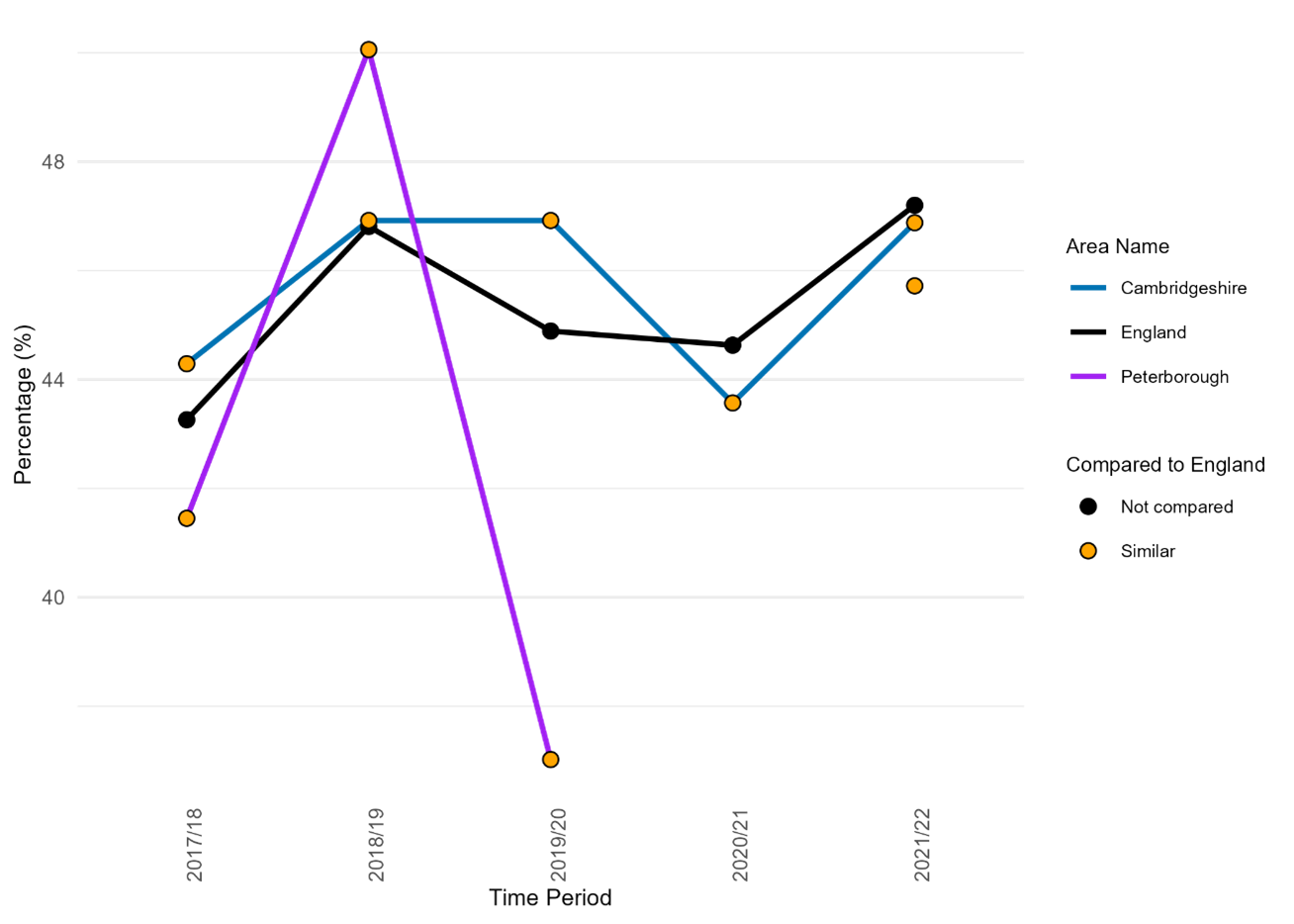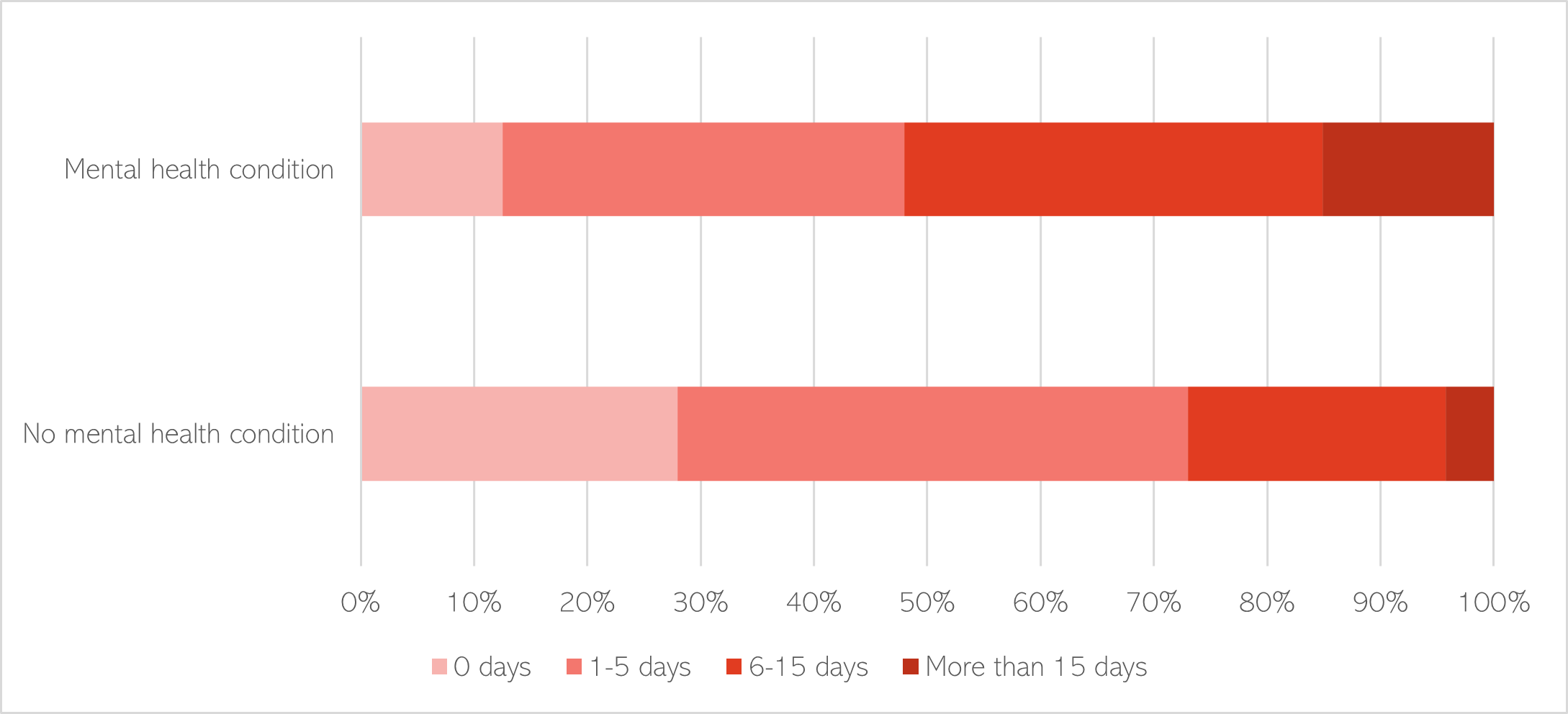Secondary school (age 11 to 16)
- In state schools in Cambridgeshire and Peterborough, children start secondary school at age 11. During this stage of their lives, children’s mental health continues to be impacted by family and environmental factors (Khan, 2016).
- At this age range, children and young people spend much of their time in school, which can be the context in which poor mental health or neurodevelopmental difficulties surface or gain wider attention (Khan, 2016). Schools can be healthy and inclusive environments, which promote mental wellbeing and help to prepare children for the future (UNICEF, 2021a); as well as places where children can experience bullying, discrimination and stress about academic performance, all of which are risk factors for poor mental health (UNICEF, 2021b).
- Children starting secondary school in 2023 will have experienced COVID-19 lockdowns during their primary school years (when they were age 8 or 9). Teachers and parents report that children whose transition to primary school was impacted by COVID-19 lockdowns missed out on opportunities and found this time period harder as a result (Bagnall et al., 2022).
Local strategies
Priorities of local strategies relating to children and young people’s mental health highlight the importance of working with young people, to support their transition to adulthood.
 Table 11: Summary of recent local strategies relating to the mental health of children and young adults aged 11 to 16
Table 11: Summary of recent local strategies relating to the mental health of children and young adults aged 11 to 16
Demographics
- There were 54,303 children aged between 10 and 14 in Cambridgeshire and Peterborough in 2021. This age group made up 6.0% of the total population of Cambridgeshire and Peterborough (Office for National Statistics, 2022b).
- There has been a 17.6% population increase in this age group between 2011 and 2021 (Office for National Statistics, 2022b).
Mental health need
Based on the national NHS Mental Health of Children and Young People Surveys (NHS Digital, 2022), it is estimated that there are 9,056 children aged between 11 and 16 with a diagnosable mental health condition, autism or ADHD in Cambridgeshire and Peterborough (95% confidence interval: 8,308 – 9,858). Note that autism and ADHD are not mental health conditions, but have been included in these estimates as diagnoses are accessed through child and adolescent mental health services (via YOUnited).
Table 7: Estimated prevalence of mental health conditions in children (aged 11 – 16) in Cambridgeshire and Peterborough. Data source: Children and Young People Mental Health Dashboard. Note: lower and upper estimates are generated from 95% confidence intervals
Full breakdowns by type of mental health condition, which include upper and lower estimates based on 95% confidence intervals, are included in the dashboard.
 Table 11: Estimated prevalence of mental health conditions in 11 to 16 year olds in Cambridgeshire and Peterborough, 2023. Data source: Children and Young People Mental Health Dashboard.
Table 11: Estimated prevalence of mental health conditions in 11 to 16 year olds in Cambridgeshire and Peterborough, 2023. Data source: Children and Young People Mental Health Dashboard.
Protective and risk factors
In Cambridgeshire and Peterborough:
- Children in care: there were 426 children in care (aged between 10 and 15) in 2021 (Office for Health Improvement and Disparities, 2023). Nationally, 45% of children in care, and 72% of children in residential care, have a diagnosable mental health condition (Lewis & Lenehan, 2012).
- Contact with the criminal justice system: 119 children and young people (aged between 10 and 17) in Cambridgeshire and Peterborough were first-time entrants to the youth justice system in 2021 (Office for Health Improvement and Disparities, 2023). One large scale survey found that 95% of people in Young Offender Institutions have a mental health condition, and 80% had multiple mental health conditions (Lader et al., 2003).
- Educational attainment: there is a gap between the average attainment 8 scores in all pupils, and pupils who are eligible for free school meals, across all districts in Cambridgeshire and Peterborough (Office for Health Improvement and Disparities, 2023).
- Physical activity: fewer than half of children and young people (aged 5 to 16) in Cambridgeshire and Peterborough meet recommended levels of physical activity (Office for Health Improvement and Disparities, 2022). Evidence suggests that physical activity helps to reduce depression symptoms, reduce anxiety and improve the self-esteem of children and young people; whilst sedentary behaviour is associated with poor mental health (Biddle & Asare, 2011).
- School absences: local rates of persistent absences from secondary schools (attendance below 90%, the equivalent of missing at least one day a fortnight) have increased since the 2018/19 school year (Office for Health Improvement and Disparities, 2022). Children who have a mental health condition are more likely to be absent from school (NHS Digital, 2022), which may disrupt their education and risks exacerbating inequalities.
Education attainment
Education disparities faced by students who grow up in income-deprived households (and are eligible for free school meals) are associated with lower earnings later in life (Office for National Statistics, 2022d), which is an important wider determinant of mental health. International studies have shown that pupils dealing with mental health problems (particularly depression) are likely to go on to have poorer school attainment, particularly in the later teenage years (Riglin et al., 2014).
Across all areas of Cambridgeshire and Peterborough, there are substantial gaps between average attainment 8 scores, and the average attainment 8 scores of pupils who are eligible for free school meals. Free school meal eligibility relates to family income and benefit status.
Figure 21: Average attainment 8 scores in all pupils, and pupils eligible for free school meals (FSM), 2021/22. Data source: Fingertips
Physical activity
Evidence suggests that physical activity helps to reduce depression symptoms, reduce anxiety and improve the self-esteem of children and young people; whilst sedentary behaviour is associated with poor mental health (Biddle & Asare, 2011).
It is recommended that all children do 60 minutes of moderate-to-vigorous physical activity (such as playing in the park) per day, across each week. However, fewer than half of children and young people (aged 5 to 16) in Cambridgeshire and Peterborough meet recommended levels of physical activity (Office for Health Improvement and Disparities, 2022). This is statistically similar to the national average.
Figure 22: Percentage of physically active children and young people (aged 5 to 16), 2018/19 – 2020/21. Data source: Fingertips. Note: to be classed as ‘physically active’, children must do 60 minutes of moderate-to-vigorous physical activity per day, across each week.
School absences
- Children who have a mental health condition are more likely to be absent from school (NHS Digital, 2022), which may disrupt their education and risks exacerbating inequalities.
- National data shows that 28% of 11- to 16-year-olds without a mental health did not miss any days from school in 2022, compared to 12% of those with a probable mental health condition (28%). 15% had missed over 3 weeks of school, compared to 4% of those unlikely to have a mental health condition (NHS Digital, 2022).
Figure 23: Number of missed days of schooling by mental health of 11- to 16-year-olds in 2022. Data source: (NHS Digital, 2022). Note: this survey did not give a full assessment of mental health, and instead estimated the likelihood that a child or young person had a mental health condition, classifying this as either: unlikely, possible or probable.
- A national survey carried out in summer term of 2021 found that many schools were experiencing above average levels of pupil attendance issues, and that pupil anxiety was the most common reasons for absence from school (Department for Education, 2022b).
- Young carers, children who are not accessing the support they need with their mental health and children with special educational needs and/or disability (SEND), and children with a history of exclusion and absence are at higher risk of persistent absence (Children’s Commissioner, 2023a).
- Nationally, the number of children who missed 50% of more possible education sessions almost doubled from the 2018/19 to the 2021/22 school year (Children’s Commissioner, 2023a). Many of these absences for reasons other than just illness, suggesting this cannot be explained by COVID-19 infections preventing people from attending school.
Overall absence rates from secondary schools have risen both locally and nationally since 2020/21, to 9.2% in Cambridgeshire, 9.3% in Peterborough and 9.0% across England.
Figure 24: Overall absence rate at state-funded secondary schools, 2015/16 – 2021/22. Data source: Fingertips
Locally, rates of persistent absences from secondary schools (defined as attendance below 90%, the equivalent of missing at least one day a fortnight) have also increased since 2018/19, in line with national trends. Over a quarter of students were persistently absent from secondary school in 2020/21. The proportion of secondary school students who were persistently absent from school was higher in Peterborough (30.0%), compared to Cambridgeshire (26.9%) or the national average national (27.7%).
Figure 25: Persistence absences from state-funded secondary school, 2014/15 – 2020/21. Data source: Fingertips
The rate of pupils who miss 50% or more school sessions (severe absences) has also increased in recent years. Special schools (schools that provide specialist support for pupils with special education needs) have the highest proportion of school absences, compared to primary and secondary schools.
What do children, young people and families say is important to mental health and wellbeing?
In 2021, the Children’s Commissioner carried out a survey of over half a million children and young people in England (equivalent to almost 6% of this age group) (Children’s Commissioner, 2022). This survey showed that young people want their schools to be a place where everyone feels able to talk about their mental health and where they can access mental health support if needed.
‘We shouldn’t just have assemblies on mental health because it’s Mental Health Awareness Week. We should have them in general and all year round’ – Boy, aged 15 (Children’s Commissioner, 2022)
Young people also highlighted they want to be able to access early support for their mental health, and that they face difficulties accessing specialist mental health services. Some young people found it very difficult to access support, particularly those dealing with past trauma, and were told by services that they were not ‘high risk’ enough to meet NHS thresholds for specialist support (Children’s Commissioner, 2022).
‘How far does it have to get? Sometimes to you sit there and you think what I have to actually do to get the support, how far do I have to go?’ – Girl, 15, in focus group (Children’s Commissioner, 2022)
A 2019 study, involving local people (over 200 children and young people, parents and professionals) in the East of England emphasise the role that education can play in promoting good mental health as top priority for mental health services (Howarth et al., 2019). They also suggest that focus should be on how mental health services are accessed and delivered, rather than the specific types of support available. Local people feel that successful mental health services should be measured in terms of children and young people’s ability to participate in their day-to-day lives, including the quality of their relationships and ability to enjoy and achieve at school, rather than focusing on symptoms of mental illness (Howarth et al., 2019).
Additional resources
- Missed opportunities: 11-15 years olds
- Making the grade: How education shapes young people’s mental health
- Promoting children and young people’s mental health and wellbeing A whole school or college approach
References
Full list of references is included at the end of this chapter.






